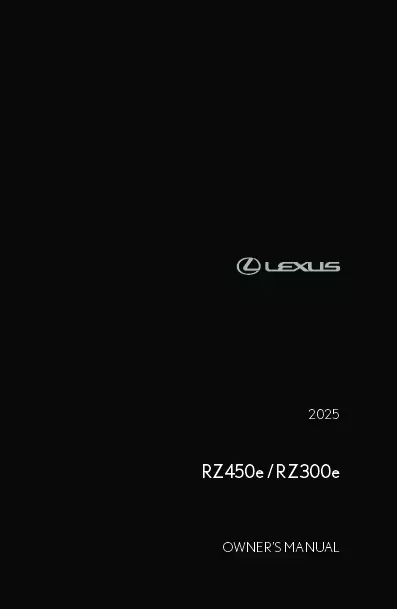2025 Lexus RZ Owner's Manual

Table of Contents
2025 Lexus RZ Overview
Owner's Manual
The owner's manual for the 2025 Lexus RZ is an invaluable resource designed to enhance the ownership experience for every driver. It serves as a comprehensive guide that details the car’s features, specifications, and maintenance requirements. This manual provides critical information on how to operate various systems within the vehicle, making it easier to understand navigation, infotainment, and safety features. Moreover, it outlines routine maintenance schedules, ensuring longevity and peak performance for your Lexus RZ. By familiarizing yourself with the owner's manual, you can maximize the potential of your vehicle and troubleshoot any minor issues that may arise.
Introduction
The 2025 Lexus RZ represents a bold step into the future of luxury electric vehicles, combining cutting-edge technology with unparalleled comfort and performance. As the first fully electric SUV from Lexus, the RZ is crafted to meet the demands of the modern driver, offering a seamless blend of style, efficiency, and advanced features. The dynamic aesthetic paired with eco-friendly credentials ensures that the RZ not only turns heads but also stands as a testament to Lexus' commitment to sustainable automotive solutions.
Powertrains
The 2025 Lexus RZ is powered by a highly-efficient all-electric powertrain that delivers exhilarating performance without compromising on range. Equipped with dual electric motors, it provides all-wheel drive capabilities, ensuring superior traction and handling in various driving conditions. The high-capacity battery offers an impressive range, allowing drivers to traverse longer distances without frequent recharging. Quick acceleration paired with a serene, quiet ride ensures that every journey is a pleasurable experience.
Trims
The RZ will be available in multiple trims, catering to the diverse preferences of luxury SUV enthusiasts. Each trim offers unique features and finishes, from the base model with its comprehensive tech package to the higher-tier options that provide enhanced comfort, premium materials, and exclusive design elements. This variety allows buyers to select a trim that best aligns with their lifestyle and desired driving experience, ensuring every driver feels special behind the wheel of their Lexus RZ.
Features
The 2025 Lexus RZ is packed with innovative features that enhance both convenience and safety. A state-of-the-art infotainment system includes a large touchscreen display, smartphone integration, and an advanced audio setup. Safety is prioritized with a suite of advanced driver-assistance systems, including adaptive cruise control, lane-keeping assist, and automated emergency braking. Luxurious touches such as customizable ambient lighting, premium upholstery, and a spacious interior further distinguish the RZ, offering a seamless blend of technology and comfort for every journey.
User manual download
The Lexus RZ owner manual for the 2025 model year is to be found in PDF downloadable format on this page. The owner manual for the model year 2025 is free and in English, but the repair manuals are usually not easy to get and may cost more.
Manual Questions
Fill the form below and someone will help you!
